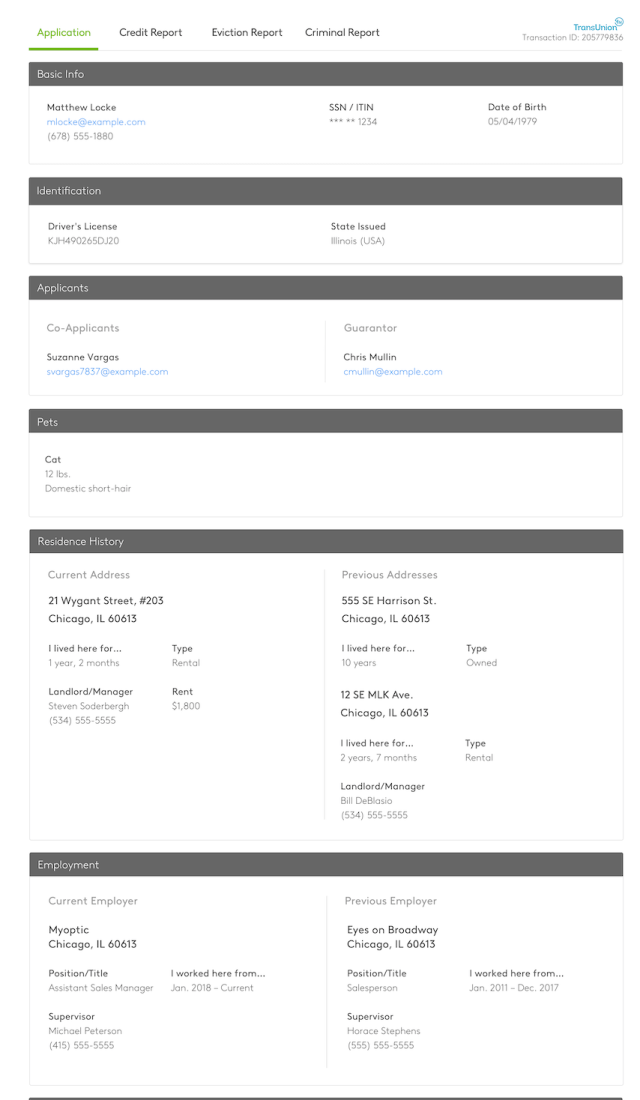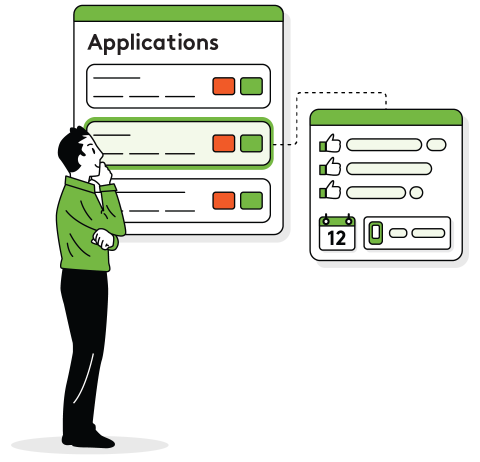As a rental manager, you're no stranger to the constant juggling of tasks. Among these, managing rental applications can often feel overwhelming. Efficient rental application templates are your best bet for streamlining the process, ensuring you don't miss quality tenants while keeping paperwork minimal.
When you list with Apartments.com, we take care of the application process for you. When renters apply to your property directly through our site, you'll get a notification when our detailed application is filled out and ready for review. All you have to do is look over one simple document.
Whether you're looking to write your own rental application template or take advantage of our all-in-one application portal, you'll have a toolkit to navigate the rental application process like a pro.
Understanding the Pain Points of Rental Applications
Reviewing rental applications can be a long and potentially stressful process. Gathering information from prospective tenants goes deeper than jotting down names and contacts. As a landlord sourcing a qualified tenant for your rental, you need to know about their employment status, their rental history, their credit score, and even personal references. Every relevant detail helps you make the best decision for your property, so you don't want to forget any important fields.
Additionally, your application needs to be user-friendly. While your forms need to be comprehensive enough to capture all the necessary information, they also need to be simple and intuitive, so potential tenants aren't discouraged from applying. If your forms are too complex or confusing, you risk scaring off good tenants and being left with incomplete applications.
Finally, it's your turn to sift through all the information collected and make an informed decision about who would make the best tenant. It's a delicate balancing act of assessing their reliability, financial stability, and overall suitability for your property. Additionally, you must ensure the process is fair and free from biases or discrimination, in line with fair housing laws.
(Note that there are certain questions that you cannot ask on a rental application due to fair housing laws. These may relate to an applicant's race, religion, disability, familial status, or other protected characteristics. It's crucial to familiarize yourself with fair housing laws to ensure compliance and avoid discrimination.)
The Benefit of Efficient Rental Application Templates
So how do you effectively consider all the information listed above? This is where rental application templates come into play. These templates are designed to capture crucial information while ensuring clarity and ease of completion for applicants.
Crafting Your Perfect Rental Application Template
If you're looking to draft your own rental application template, there are a few things to consider before diving in.
Essential Information to Capture
When you're designing a rental application template, make sure you're capturing all the essential information. Don't forget about the financial matters too - income details, credit scores, and more. By collecting all this information, you will have a clear picture of who your potential tenant is and how reliable they might be. Essential details to ask for include:
- Name
- Birthday
- Current address
- Preferred move-in date
- Phone number
- Social Security number (This is legal to request but is not required or recommended. If you request and receive an SSN, you may be held liable if an applicant's identity is stolen.)
- Employment information
- Any co-applicants
- Any guarantors
- ID photo
- Vehicle information
- Income verification, such as pay stubs
- Rental history
- References (from past landlords, former managers, or co-workers)
Integrating Screening Tools
In addition to self-reported information, consider integrating screening tools into your template. These can help you verify the information provided and assess an applicant's suitability. Maybe it's a tool that checks employment history or one that does a quick credit check. It might take some effort to set up, but it'll save you time in the long run.
Screening questions are not the same as a background check, which legally requires written consent from the tenant. If you want to proceed with an applicant, a background check will be necessary. At this point, you’ll need to know about criminal history, eviction history, and credit reports. Because this information is sensitive, hold off on asking about it on the application. You want your potential tenants to know that their information will be dealt with securely and professionally.
Optional Sections
Some application fields aren't crucial, but they can give you some extra insight into your applicants. Think about including sections for personal references or pet information. Maybe even a space for applicants to share a bit about themselves - their hobbies, lifestyle, or why they're interested in your property. Remember, every little bit of information helps!
Designing for Clarity and Ease of Completion
Always design your application for clarity and ease of completion. You don't want your applicants to feel like they're solving a complex puzzle, so keep things simple and straightforward. Use clear language, break sections down into manageable chunks, and provide instructions where necessary. Trust me, your applicants will thank you for it!
Utilizing Conditional Logic
Here's where things get a bit techy. If you can, try utilizing conditional logic in your template. This means that the questions or sections an applicant sees can change based on their previous answers. For example, if they say they have pets, a new section asking about the type and number of pets could appear. It's a great way to keep your application relevant and concise.
Going Beyond the Template: Streamlining the Application Process
Pre-Screening Questions
Think of pre-screening questions as your first line of defense. They're a set of questions you ask right at the start to weed out any applicants who won't be a good fit based on your non-negotiables. Maybe they've got three pets when you limit residents to one, or their move-in date is months later than your unit’s availability.
Pre-screening questions also give you an idea of who the renter is and what they're looking for. Think of questions like:
- What is your preferred move-in date?
- Why are you moving?
- How many people will be moving into the property?
- What is your gross income (before taxes)?
Automated Data Verification
Automated data verification helps combat false or inaccurate information. The system will automatically verify the details provided – employment history, credit score, you name it. It's like having a personal detective, ensuring everything checks out.
Communication Automation
Keeping up with emails and phone calls from multiple applicants can keep you busier than you want to be. Communication automation can help take care of all your correspondence, from initial contact to final decision. It saves you time, keeps your applicants informed, and ensures no one slips through the cracks.
Online Application Portals
An efficient rental application template is just the beginning. Online application portals like Apartments.com can simplify the submission and review process by letting applicants submit their applications digitally. Instead of dealing with physical forms and paperwork, everything's done online. It's easier for you and your applicants. They can fill out their details at their convenience, and you'll have all the information in one neat, organized space.
Apartments.com's online application portal is designed to capture all the nitty-gritty details you need about potential tenants, all in a way that's clear and easy for applicants to complete. From there, you can easily sort through the information, spot any red flags, and select the most suitable tenant.
Apartments.com’s Rental Application
When you list your property on Apartments.com, you can allow millions of potential renters to view and apply to your rental directly from your listing! Our rental application is designed to collect relevant information you don't want to miss - name, government identification, pets, residence and employment history, and more. When a renter submits an application, it is securely shared with you. From there, you get a notification and are able to review every detail the applicant has filled out.
When you open a renter's application through Apartments.com, it will look something like this:

All the important details are laid out clearly, from basic information to guarantors to rental history. Should you get consent to run a credit or background check later, that information will also be attached to the renter's profile. A credit report on Apartments.com is run through TransUnion and will look like this:

Optional sections included on an Apartments.com rental application include sections for personal references or pet information. When a tenant applies, they also have the option to send you a short message about themselves - where they're from, why they're interested in your rental, and a little about who they are. Every bit of information is helpful to get to know your prospective renters a little better.
With all your applicants’ information in one place, you can make a quick and informed decision about what’s best for you and your property without sifting through stacks of documents.
Key Takeaways
Incorporating essential information, optional sections, and utilizing advanced strategies with efficient rental application templates can streamline your application process and help you find the right tenants more efficiently. Remember, effectively evaluating rental applications involves asking relevant questions and considering factors such as rental history and credit checks.
Having an efficient rental application template in your toolkit can truly streamline your process, saving you time and making your job easier. So why wait? Dive into these tips today and let rental application templates do the hard work for you.











